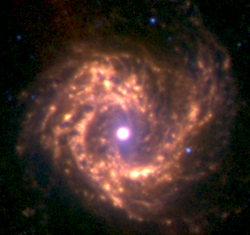Messier 61
J2000 epoch) | |
|---|---|
| Constellation | Virgo |
| Right ascension | 12h 21m 54.9205s[3] |
| Declination | +04° 28′ 25.631″[3] |
| Redshift | 0.005224±0.000007[3] |
| Heliocentric radial velocity | 1566±2 km/s[3] |
| Galactocentric velocity | 1483±4 km/s[3] |
| Distance | 52.5 ± 2.3 Mly (16.10 ± 0.71 Mpc) |
| Apparent magnitude (V) | 9.7[4] |
| Characteristics | |
| Type | SAB(rs)bc,[3] HIISy2[3] |
| Size | ~92,300 ly (28.30 kpc) (estimated)[3] |
| Apparent size (V) | 6.5′ × 5.8′[3] |
| Other designations | |
| HOLM 379A, IRAS 12194+0444, NGC 4303, UGC 7420, MCG +01-32-022, PGC 40001, CGCG 042-045[3] | |
References: SIMBAD: Search M61 | |
Properties
M61 is one of the largest members of Virgo Cluster, and belongs to a smaller subgroup known as the S Cloud.[7][8] The morphological classification of SAB(rs)bc[3] indicates a weakly-barred spiral (SAB) with the suggestion of a ring structure (rs) and moderate to loosely wound spiral arms.[9] It has an active galactic nucleus[10] and is classified as a starburst galaxy containing a massive nuclear star cluster with an estimated mass of 1 million solar masses (M☉) and an age of 4 million years,[11] as well as a central candidate supermassive black hole weighing around 5 million M☉.[12]
It cohabits with an older massive star cluster as well as a likely older starburst.
Supernovae
Eight supernovae have been observed in M61, making it one of the most prodigious galaxies for such cataclysmic events.[15][16][5] These include:
- SN 1926A (Type II, mag. 14)[17] was discovered by Max Wolf and Karl Wilhelm Reinmuth on 9 May 1926.[18]
- SN 1961I (Type II, mag. 13)[19] was discovered by Milton Humason on 3 June 1961.[20][21]
- SN 1964F (Type II, mag. 14)[22] was discovered by Leonida Rosino (bio-it) on 30 June 1964.[23]
- SN 1999gn (Type II, mag. 16)[24] was discovered by Alessandro Dimai on 17 December 1999.[25]
- SN 2006ov (Type II, mag. 14.9)[26] was discovered by Kōichi Itagaki on 24 November 2006.[27]
- SN 2008in (Type II, mag. 14.9)[28] was discovered by Kōichi Itagaki on 26 December 2008.[29]
- SN 2014dt (Type Ia-pec, mag. 13.6)[30] was discovered by Kōichi Itagaki on 29 October 2014.[31]
- SN 2020jfo (Type II, mag. 16)[32][33] was discovered by the Zwicky Transient Facility on 6 May 2020.
Gallery
-
M61 (with NGC 4301 in upper left) imaged by the Vera C. Rubin Observatory
-
Spiral galaxy Messier 61 is aligned face-on towards Earth.[34]
-
Messier 61 image using data from Hubble's Wide Field Camera 2
-
Amateur Image of Messier 61 Showing Supernova 2008in on April 16, 2009
-
Infrared image of M61 taken by the Spitzer Space Telescope
-
Messier 61 with SN2020jfo (Supernova) observed on May 15, 2020
-
M61 galaxy image that incorporates data from not only Hubble, but also the FORS camera at the European Southern Observatory’s Very Large Telescope
See also
- List of Messier objects
References
- ^
Tschöke, D.; Hensler, G.; Junkes, N. (2000). "X-rays from the barred galaxy NGC 4303". Bibcode:2000A&A...360..447T.
- ^ "A hungry starburst galaxy". ESA/Hubble Picture of the Week. Retrieved 29 April 2014.
- ^ a b c d e f g h i j k "Results for object MESSIER 061". NASA/IPAC Extragalactic Database. NASA and Caltech. Retrieved 2006-11-18.
- ^ "Messier 61". SEDS Messier Catalog. Retrieved 29 April 2022.
- ^ a b "Messier 61". Archived from the original on 2017-01-06. Retrieved 2017-01-11.
- ^ "The Virgo III Groups". Atlas of the Universe. Retrieved 2010-11-27.
- ^ "Galaxy On Line Database Milano Network (GOLDMine)". Archived from the original on 2012-06-03. Retrieved 2012-08-06.
- ^ "The Virgo Cluster". Retrieved 2013-04-06.
- ^
de Vaucouleurs, Gérard (April 1963). "Revised Classification of 1500 Bright Galaxies". Astrophysical Journal Supplement. 8: 31. doi:10.1086/190084.
- ^
Jiménez-Bailón, E.; Santos-Lleó, M.; Mas-Hesse, J. M.; Guainazzi, M.; Colina, L.; Cerviño, M.; González Delgado, Rosa M. (2003). "Nuclear Activity and Massive Star Formation in the Low-Luminosity Active Galactic Nucleus NGC 4303: Chandra X-Ray Observations". S2CID 12969809.
- ^ hdl:10261/191615.
- S2CID 849621.
- ^
Koopmann, R.; Kenney, J. D. P. (2004). "Hα Morphologies and Environmental Effects in Virgo Cluster Spiral Galaxies". The Astrophysical Journal. 613 (2): 866–885. S2CID 17519217.
- ^
Kenney, J. D.; Young, J. S. (1986). "CO in H I-deficient Virgo cluster spiral galaxies". doi:10.1086/184614.
- ^ Supernovae which have been observed in Messier catalog galaxies
- ^ "List of Supernovae". Central Bureau for Astronomical Telegrams. Retrieved 2011-07-03.
- ^ "SN 1926A". Transient Name Server. IAU. Retrieved 26 November 2024.
- ^ Stromgren, Elis (15 May 1926). "Circular No. 111". Central Bureau for Astronomical Telegrams. Observatoire De Copenhague. Retrieved 26 November 2024.
- ^ "SN 1961I". Transient Name Server. IAU. Retrieved 26 November 2024.
- ^ Thernoe, K. A. (8 June 1961). "Circular No. 1761". Central Bureau for Astronomical Telegrams. Observatory Copenhagen. Retrieved 26 November 2024.
- doi:10.1086/127790.
- ^ "SN 1964F". Transient Name Server. IAU. Retrieved 27 April 2025.
- ^ Petersen, J. Otzen (3 July 1964). "Circular No. 1868". Central Bureau for Astronomical Telegrams. Observatory Copenhagen. Retrieved 26 November 2024.
- ^ "SN 1999gn". Transient Name Server. IAU. Retrieved 27 April 2025.
- Bibcode:1999IAUC.7335....1D.
- ^ "SN 2006ov". Transient Name Server. IAU. Retrieved 27 April 2025.
- Bibcode:2006IAUC.8781....2P.
- ^ "SN 2008in". Transient Name Server. IAU. Retrieved 27 April 2025.
- Bibcode:2008CBET.1636....1N.
- ^ "SN 2014dt". Transient Name Server. IAU. Retrieved 27 April 2025.
- Bibcode:2014CBET.4011....1N.
- ^ "SN 2020jfo". Transient Name Server. IAU. Retrieved 23 October 2021.
- S2CID 17688690.
- ^ "A portrait of a beauty". www.eso.org. Retrieved 7 January 2019.
External links
- messier.seds.org/m/m061.html
- Messier 61 on


![Spiral galaxy Messier 61 is aligned face-on towards Earth.[34]](http://upload.wikimedia.org/wikipedia/commons/thumb/2/23/Messier61_-_ESO_-_Potw1901a.tif/lossy-page1-216px-Messier61_-_ESO_-_Potw1901a.tif.jpg)





